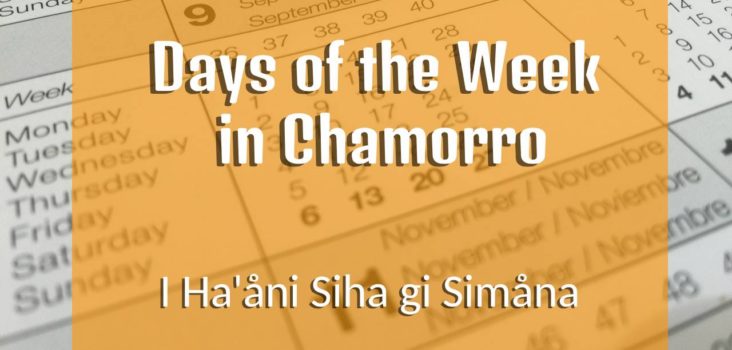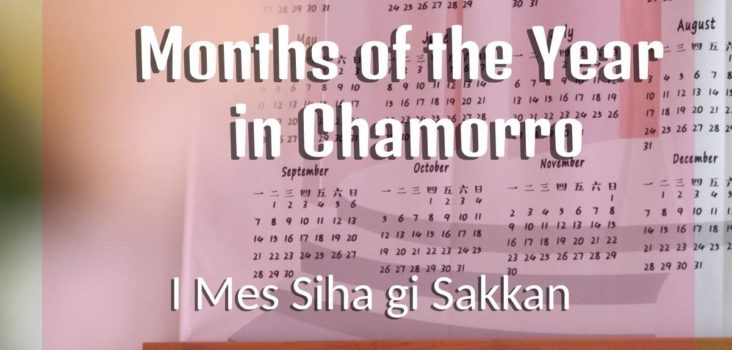December 15, 2020
Chamorro Word Stress
Where you put the stress on a word in Chamorro will help you to be understood by native speakers. It’s important in many languages as it can change the meaning of the word. Take for instance the word desert. At first glance, your thoughts immediately go to a dry, barren expanse of land with lots of sand. That’s because you read the word as DEH-zehrt, with the stress on the first syllable. Now try reading it again with the stress on the second syllable and now your thoughts turn towards abandoning someone or something. With the stress on the first syllable, the word desert is the noun, but put the stress on the second syllable and you get desert as a verb.
There aren’t a lot of words like this; that is words that change meaning depending on the stress. In fact, you need only to remember a few rules when it comes to understanding which syllable of a word to emphasize.
Which syllable has the stress?
For the most part, the stress is placed on the penultimate (a fancy term meaning “second to the last”) syllable of a word. For a two-syllable word that stress will be on the first syllable.
hågu – HUH-goo
tåya’ – TUH-dzah
go’te – GOH-tee
lepblo – LEHP-bloo
With three-syllable words:
kareta – kah-REH-tah
ga’lågu – gah-LUH-goo
kastigu – kahs-TEE-goo
This rule of placing the stress on the penultimate syllable is still followed when adding a possessive determiner (i.e. -hu, -ku, -mu, etc.). The possessive determiner is considered part of the word.
lepblo – LEHP-bloo → lepblo-ku – lep-BLOH-koo
kareta – kah-REH-tah → karetå-hu – kah-reh-TUH-hoo
Please note that the possessive determiners -måmi, -miyu and -ñiha have two syllables, so the stress will lie on the first syllable
karetan-måmi – kah-reh-tahn-MUH-mee
lugåt-miyu – loo-gaht-MEE-dzoo
gima’-ñiha – gee-mah-NYEE-hah
Chamorro Word Stress in Words Derived from Prefixes
There are words in Chamorro derived by using a prefix. When this happens, the stress is usually on the prefix.
Prefix a – reciprocal prefix (i.e. to do an action to “each other” )
atungo’ – AH-too-ngoo
asodda’ – AH-sohd-dah
Prefix e – Prefix meaning “to hunt for”
epånglao – EH-pahng-lah-oh
esalåpe’ – EH-sah-lah-pee
Prefix acha – Prefix denoting equality
achamaolek – a-CHA-mah-oh-lick (maolek = good)
achametgot – a-CHA-met-goot (metgot = strong)
Prefix hat – Prefix denoting movement towards or away from a subject
hatmagi – HAHT-mah-gee
hatguatu – HAHT-gwah-too
Prefix na’ – Causative prefix meaning to cause something to be. Words created from prefix na’ actually have two ways they can be understood. If we place the stress on the penultimate syllable (second to the last), the word is understood as a verb, BUT if the stress is on the prefix na’, it will be understood as an adjective. For example, the word na’puti pronounced nah-POO-tee will be understood as to cause someone pain. But if it’s pronounced NAH-poo-tee, it will be taken as an adjective and understood as “pain-causing” or “hurtful”.
When attaching a possessive determiner in the case of the a-derived nouns, it reverts back to stress on the penultimate syllable.
atungo’-hu – ah-too-NGOH-hoo
asodda’-hu – ah-sohd-DAH-hoo
Chamorro Word Stress in Words Borrowed from Spanish
Of course, there had to be exceptions, but fortunately, there are not too many of these. Most of these words have come from Spanish and have retained their original pronunciations.
interes (n. interest) – een-teh-REHS
mamadot (n. baby’s bottle) – mah-mah-DOHT
kulot (n. color) – koo-LOHT
tason (n. bowl) – tah-SOHN
prinsipi (n. prince) – PRIN-see-pee
åtbot (n. type of tree) – UHT-boot
December 5, 2020
Talking About the Weather in Chamorro

The weather is a subject that everyone talks about as it is a sore spot when it’s bad and the highlight of someone’s day when it’s not. This article will hopefully provide enough useful terms so you can talk about the weather in Chamorro.
Bonitu na ha’åni, no?
Beautiful day, isn’t it?
Atan ha’ este na uchan!
Just look at this rain!
Chamorro Weather Vocabulary
To help you learn how to talk about the weather, you’ll have to learn the different words used to describe the weather.
Chamorro Weather Nouns
- weather: i tiempo or i klema
- sun: atdao
- clouds: mapagåhes
- rain: uchan
- thunder: hulu
- lightning: låmlåm
- fog: afao
- wind: månglo’
- storm/typhoon: pakyo
- rainbow: isa
- degrees: grådu
- condition: kondision
- season: tiempo
NOTE: You may have noticed that there are two words for weather: tiempo and klema. They mean the same thing. This can get confusing since you may have already learned and used tiempo in the contexts of talking about time in general, or to refer to a specific period of time, as in a season.
Chamorro Weather Adjectives
- sunny: somnak
- cloudy: nupblådu
- windy: månglo’, guaifon
- rainy: uchan
- bad weather: chata’an
- hot: maipe
- cold: manengheng
A lot of times in Chamorro, a noun can also be used as an adjective. It’s understood that something is “being” that noun. This can be seen in the words uchan yan månglo’, which are the words for “rain” and “wind”, respectively, but can also be understood as “rainy” and “windy”.
Chamorro Words for Extreme Weather Conditions
- storming: papakyo
- earthquake: linao
- rough waters: nåpu
Asking about the Weather
If you need to ask about the weather, you can use the following.
How’s the weather?
Tumaimamanu i tiempo?
What’s the weather like?
Håfa i klema?
Talking about Seasons
Because the Marianas is in the tropics, there are really only two seasons:
- tiempon somnak – dry season (lit. “sunny season”)
- tiempon uchan – rainy season (lit. “rainy season”)
Featured Image Photo by Brett Sayles from Pexels
October 8, 2020
Telling Time in Chamorro

The word “time” can be translated three different ways in Chamorro:
| ora | Time as in telling time. “I ora” means “the hour”. |
| tiempo | General period of time, which can be used when talking about seasons. |
| biahe | An instance of time, as in a number of times. |
In this article, we’ll be talking about i ora, or “the hour”. It’s easy to tell time in Chamorro. You just have to remember your numbers.
How to Tell Time in Chamorro
What time is it? Ki ora?
| CHAMORRO | ENGLISH |
| Ala una | 1 o’clock |
| Alas dos | 2 o’clock |
| Alas tres | 3 o’clock |
| Alas kuåtro | 4 o’clock |
| Alas singko | 5 o’clock |
| Alas sais | 6 o’clock |
| Alas siette | 7 o’clock |
| Alas ochu | 8 o’clock |
| Alas nuebi | 9 o’clock |
| Alas dies | 10 o’clock |
| Alas onse | 11 o’clock |
| Alas dosse | 12 o’clock |
Note that 1 o’clock is different from the rest as it is just “ala” and not “alas” and the word for one is the Spanish feminine form “una”.
Beyond the Hour
If we wish to say that it is half past the hour we would use the expression i media , which is a direct borrowing of the Spanish phrase meaning “and a half”.
Pot ihemplo: 7:30 ~ Alas siette i media.
You can also specify the exact minute, if you wish to be specific. For example, to say it is 10:20 in the morning, you would say:
Alas dies bente
Or you could also say:
Bente pasåo alas dies, which literally means “20 past 10”.
NOTE: When giving the time, Chamorros like to give a general idea of what the time is. They’ll just say it is para (to) or pasao (past) a specific time.
| Para alas 5 | It’s 5 o’clock. |
| 10 para alas 5 | It’s 10 (minutes) ’til 5 o’clock. |
| Pasao alas 5 | It’s past 5 o’clock. |
| 10 pasao alas 5 | It’s 10 past 5 o’clock. |
Adding Time of Day
If you want to be more specific as to the time of day, add the following expressions after the time:
| …gi ega’an | in the morning |
| …gi chatanmak | in the wee hours of the morning; before dawn |
| …gi talo’ani | in the afternoon |
| …gi pupuengi | in the evening |
| …gi tatalo’ puengi | at midnight |
To say, seven in the morning, you would say:
Alas siette gi ega’an.
The words oga’an and chatanmak are both used for the morning. Chatanmak refers to the period right before daybreak. As soon as there’s light, it is considered oga’an. So depending on where you are in the world when you use oga’an may be different.
The word talo’åni literally means “middle of the day”, and refers to the time of day when the sun is at its highest. We note this only because you may hear “afternoon” used differently among speakers. In English, afternoon is any time that is after noon, that is 12 pm, through the evening. In Chamorro, you may hear someone say “Alas 11 gi ega’an”, following how time is spoken in English. Or you might also hear “Alas 11 gi talo’åni”, taking into account that at 11 a.m. the sun is already reaching its highest point.
How to Ask for the Time
We already learned how to give the time, so let’s take a look at the ways you can ask for the time.
The main phrase you need to know is:
Ki ora? What time is it?
If you want to ask when a specific event is happening, like a party or movie, you would simply ask what time something is (that is, what time it’s happening).
Ki ora i movie? What time is the movie?
Ki ora i gipot? What time is the party?
If you want to ask a more complex question, such as what time someone did something or going to do something you would need to ask ki ora na… (what time is it that…)
To ask what time someone did something,
Ki ora na makmåta hao? What time did you wake up?
To ask what time someone is going to do something we use ki ora na with a future statement.
Ki ora na para un fatto?
What time will you arrive?
Ki ora na para u falak i tenda si David?
What time is David going to the store?
To ask what time something usually happens, we must employ the ongoing, or progressive, form of the verb.
Ki ora na makmamata hao?
What time do you wake up?
Ki ora na mamaigo’ hao?
What time do you sleep?
Ki ora na madadandan i kampana.
What time does the bell ring?
Ki ora na mabababa i Target?
What time does Target open?
Ki ora na humåhånao hao para i che’cho’-mu?
What time do you leave for work?
September 30, 2020
Chamorro Days of the Week

Seven little words that you’ll use all the time when speaking Chamorro: i ha’åni siha gi simåna (the days of the week). Estegue’ siha! Here they are!
How to say the days of the week in Chamorro
| CHAMORRO | ENGLISH | PRONUNCIATION |
| Lunes | Monday | loo-niss |
| Måttes | Tuesday | maht-tiss |
| Metkoles | Wednesday | meht-koo-liss |
| Huebes | Thursday | hoo-eh-biss |
| Betnes | Friday | beht-niss |
| Såbalu | Saturday | suh-bah-loo |
| Damenggo | Sunday | dah-mehng-goo |
Other Useful Words and Phrases
| ENGLISH | CHAMORU | PRONUNCIATION |
| day | diha (dia) | dee-hah (dyah) |
| day | ha’åni | hah-uh-nee |
| today | på’go | pah’-goo |
| yesterday | nigap | nee-gap |
| tomorrow | agupa’ | ah-goo-pah’ |
| the day before yesterday | nigapña | nee-gap-nyah |
| the day after tomorrow | agupa’ña | ah-goo-pah’-nyah |
| the next day | i sigiente dia | ee see-gyen-tee dee-ah |
| week | simåna | see-mah-nah |
| last week | ma’pos na simåna | muh-poos nah see-mah-nah |
| week before last | ma’posña na simåna | muh-pohs-nyah nah see-mah-nah |
More Useful Expressions of Time
Hafa i dia på’go?
What day is today?
Maseha ngai’an malago’-mu
Whenever you want
Trabiha
Not yet
Ti apman
It won’t be long. (Soon)
Ha’åni or Dia
In Chamorro, we sometimes have two words for the same thing. This is true for the word for day, which can be spoken as ha’åni or dia. The former is rooted in indigenous Chamorro and the latter borrowed from Spanish. There is no strict rule as to when you should use either, but there is a predilection among native speakers toward using ha’åni more when describing the day and dia for when talking about the day in the calendar sense. As a learner of Chamorro, take note when listening to conversations in Chamorro; try to note the context in which each word is used.
The Origin of the Days of the Week
The Chamorro names for the days of the week come from the Spanish days of the week, which get their names from planets and gods.
| CHAMORU | SPANISH | MEANING | |
| Lunes | Lunes | Day of the Moon | |
| Måttes | Martes | Day of Mars | |
| Metkoles | Miercoles | Day of Mercury | |
| Huebes | Jueves | Day of Jupiter | |
| Betnes | Viernes | Day of Venus | |
| Såbalu | Sabado | From Hebrew word shabbat, the day of rest | |
| Damenggo | Domingo | Day of God, or Day of the Lord |
September 28, 2020
Chamorro Months of the Year

When we want to talk about important events like birthdays and holidays we have to learn some very important words in CHamoru: the names of the months of the year. What’s great is that you have 12 opportunities out of the year to practice your Chamorro! So nihi! Let’s go and do this.
Here are the names of i mes siha gi sakkan (the months in the year).
| CHAMORRO | ENGLISH | PRONUNCIATION |
| Ineru | January | ee-neh-roo |
| Fibreru | February | fee-breh-roo |
| Måtso | March | maht-soo |
| Abrit | April | ah-britt |
| Måyu | May | mah-dzoo |
| Huño | June | hoo-nyoo |
| Hulio | July | hoo-lyoh |
| Agosto | August | ah-gohs-too |
| Septembre | September | sep-tehm-bree |
| Oktubre | October | ohk-too-bree |
| Nobembre | November | noh-behm-bree |
| Disembre | December | dee-sehm-bree |
Talking About Dates in Chamorro
Saying i fecha, or “the date”, in Chamorro is almost the same as in English except for a few details. Chamorro days are often preceded by the word dia (or diha), meaning “day”. Traditionally, the day came before the month, but now it is common to say it the English way as well. In both languages, the year always comes after the month and day, regardless of the order.
You can use the following patterns to help you write the date:
dia + number + gi + month + year
or
month + dia + number + year
Here are some examples:
| CHAMORU | ENGLISH |
| Dia 3 gi Oktubre | October 3 |
| Oktubre dia 3 | October 3 |
| Dia 3 gi Oktubre 2014 | October 3, 2014 |
How To Say Your Birthday
When you want to tell someone when your kumpleaños or ha’ånen mafañagu-mu (both mean birthday) is, you can say it in a few ways:
| Mafañågu yu’ gi Hulio dia 14. | I was born on July 14. |
| I kumpleaños-hu i dia 14 gi Hulio. | My birthday is July 14. |
| I ha’ånen mafañagu-hu i dia 14 gi Hulio. | My birthday is July 14. |
Ancient CHamoru Calendar
Before the Spanish arrived, the ancient Chamorros used a 13-month calendar based on the lunar cycle.
| ENGLISH | CHAMORU |
| January | Tumaiguini |
| February | Maimo’ |
| March | Umatalaf |
| April | Lumuhu |
| May | Makmamao |
| June | Mananaf |
| July | Semu |
| August | Tenhos |
| September | Lumamlam |
| October | Fanggualo’ |
| November | Sumongsong |
| December | Umayanggan |
| Umagahaf |